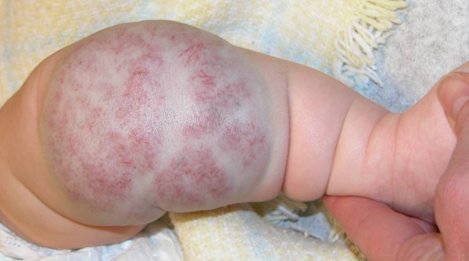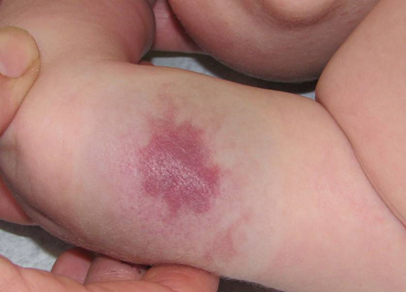Congenital hemangiomas can be broken down into two categories:
- Noninvoluting congenital hemangioma
- Rapidly involuting congenital hemangioma
Noninvoluting Congenital Hemangiomas (NICH)
The characteristics of this type of congenital hemangioma are:
- They are present at birth and grow as your child grows.
- They do not go through a regression (shrinking) phase.
Treatment Options for NICH
A NICH may be surgically removed. If the NICH is large, a radiologist may need to perform an embolization procedure prior to surgery to help control the bleeding. Embolization helps decrease the blood flow to a vascular lesion in order to reduce blood loss during surgery.
Rapidly Involuting Congenital Hemangiomas (RICH)
RICHs also are present at birth. However, they go through a rapid regression phase and may be completely gone by the time your child is 12 to 18 months old. Surgery may be necessary even after regression of the tumor to reduce loose skin or scarring.
What Causes a Congenital Hemangioma?
There is no known cause of congenital hemangiomas. Children's Wisconsin is doing research to find causes of vascular malformations and tumors, including congenital hemangiomas.
Treatment Options for Congenital Hemangiomas
Treatment options for your child will depend upon the size, type and location of the lesion.
- Watchful waiting: If your child’s lesion is shrinking, the doctor may choose observation instead of treatment.
- Surgery: Surgery to remove the lesion is the best option if there are complications such as skin breakdown and bleeding. Your child’s doctor may consult a cardiologist before surgery if the lesion is very large and has significant blood flow through it.
Although there are several effective topical and oral treatments for infantile hemangiomas, these do not work for congenital hemangiomas.
Complications
There are a number of potential complications of congenital hemangiomas, including:
- Skin breakdown
- Bleeding
- Heart problems (though rare) because of the large amount of blood flow to the lesion





